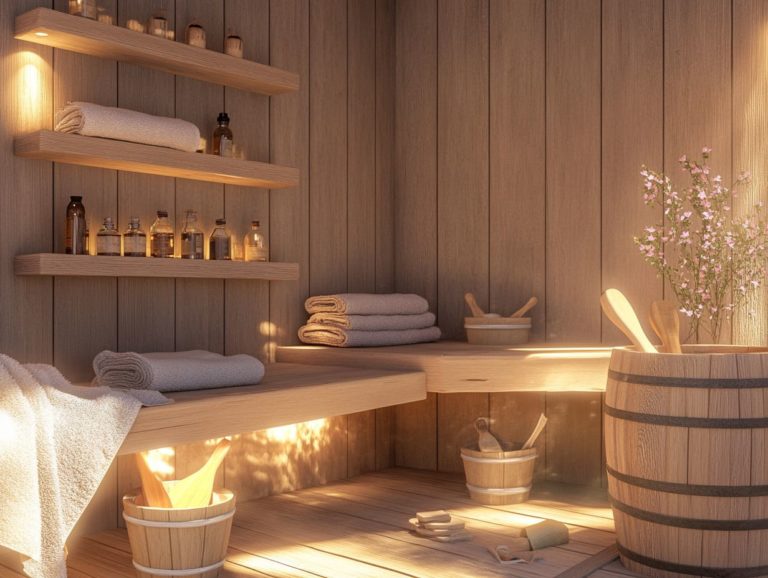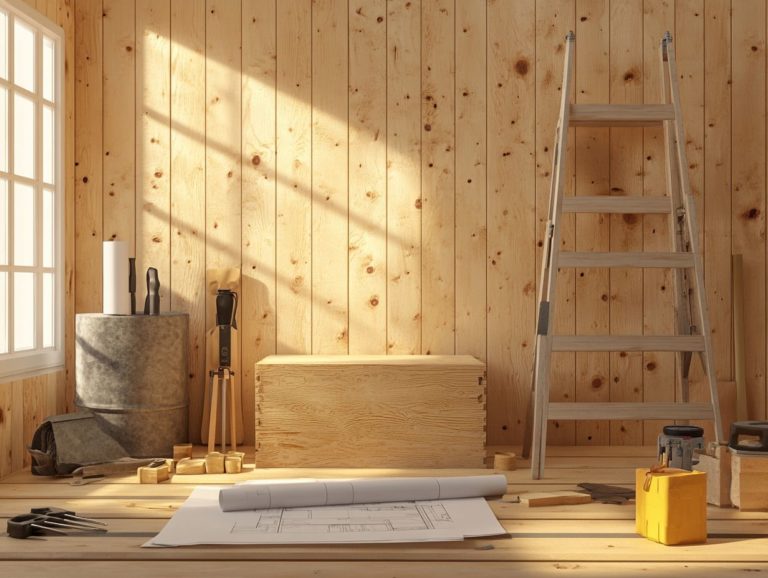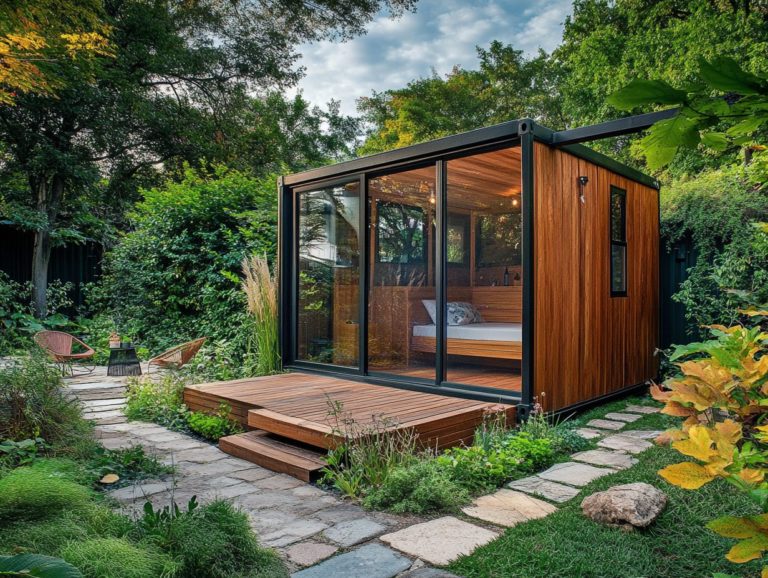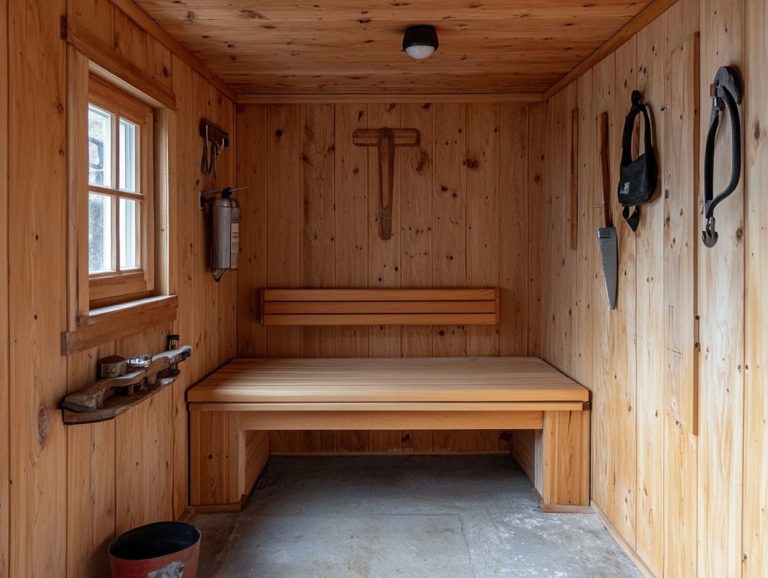“Finding the Perfect DIY Sauna Design for You”
Saunas present a remarkable fusion of relaxation and wellness, making them a sought-after enhancement for homes and backyards alike, especially when considering a DIY sauna project.
As you delve into the world of saunas, whether you re drawn to the charm of traditional wood-burning sauna models or the sleek efficiency of modern infrared designs, selecting the ideal sauna transforms into an exhilarating journey.
This article will guide you through the various types of saunas, highlighting key considerations for your sauna design and offering practical DIY ideas.
You ll also find important safety tips and maintenance advice for your sauna. Embrace the opportunity to discover how to create your dream sauna experience tailored just for you!
Contents
Key Takeaways:
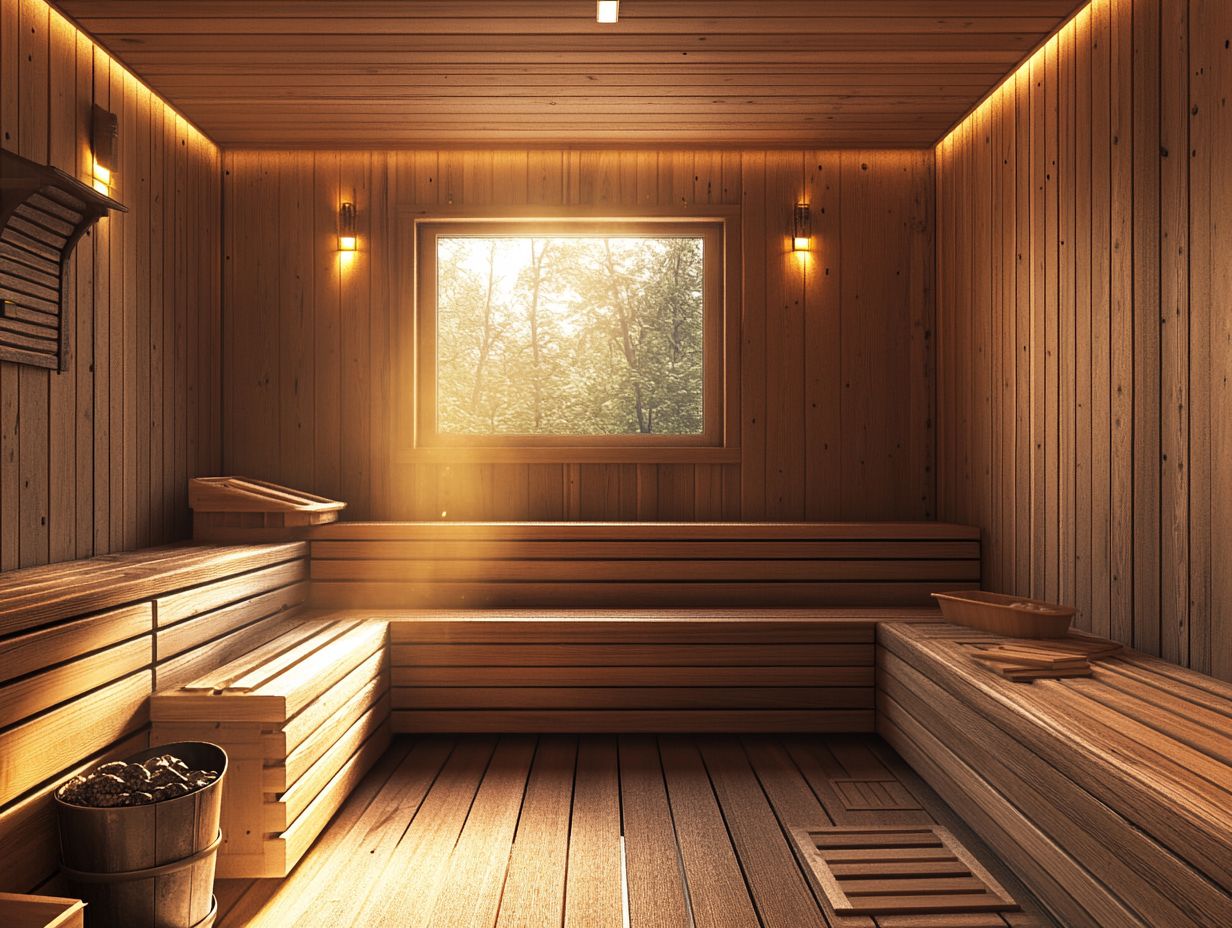
- Understand the different types of saunas and their benefits, such as traditional vs. infrared saunas.
- Consider factors like space, budget, and personal preference when choosing the right sauna design for you.
- Keep safety in mind when building and maintaining your DIY sauna. Follow a step-by-step guide for best results.
Understanding Saunas
Saunas are cherished traditions from the Nordic countries. They offer more than just a space to unwind; they nurture both your body and mind.
With a variety of designs available from traditional wood-burning models to sleek modern infrared options you can find unique sauna experiences that fit your preferences.
For those with a DIY spirit, sauna projects can ignite your creativity. They encourage you to explore the essentials of sauna construction, including materials (the items used to build), ventilation (the way air flows in and out), and design aesthetics (the way your sauna looks and feels).
Whether you opt for fragrant cedar wood or choose the convenience of an electric heater, grasping the nuances of sauna installation is vital for crafting that perfect sanctuary at home.
What is a Sauna?
A sauna is your personal haven, a small room meticulously designed for invigorating heat sessions. These sessions can elevate your overall experience and deliver a plethora of health benefits, including relaxation and detoxification.
Rooted in Finnish culture, these heated retreats do more than just promote well-being; they serve as vibrant communal gathering spaces that foster meaningful social connections. Saunas come in various forms, with traditional setups featuring wooden benches and a stove or heater that cranks up the heat, encouraging a good sweat and soothing muscle relaxation.
In contrast, infrared saunas utilize cutting-edge technology to emit radiant heat, allowing for a more comfortable experience at lower ambient temperatures while penetrating the skin more deeply. This unique capability can expedite detoxification and boost circulation, making both types of saunas an invaluable addition to your wellness routine.
Types of Saunas
Saunas offer a diverse range of types, each delivering a distinct heating experience tailored to your preferences. The traditional sauna, with its wood-burning stove, envelops you in an authentic warmth that harkens back to ancient practices.
On the other hand, the modern infrared sauna stands out for its efficiency and impressive health benefits. Grasping the nuances between these options is crucial for choosing the perfect sauna that aligns with your space and personal needs.
Traditional vs. Infrared
The key difference between traditional and infrared saunas lies in their heating methods. Traditional saunas rely on a wood-burning stove or electric heater to warm the air. In contrast, infrared saunas use infrared light to directly heat your body. This creates distinctly different sauna experiences.
When deciding which type suits you best, consider the pros and cons of each option. They are shaped by personal preferences, health benefits, and how effectively they distribute warmth. Many individuals gravitate toward traditional saunas for the enveloping heat they provide, which evokes a comforting, spa-like ambiance. This high heat promotes relaxation and can lead to significant sweating, often believed to assist in detoxification.
If you prefer a gentler, more targeted heat, infrared saunas might be the better choice. They are particularly beneficial for muscle recovery and are ideal for those sensitive to high temperatures. Understanding these differences can greatly enhance your sauna experience and help you select the option that best meets your needs.
Choosing the Right Sauna Design
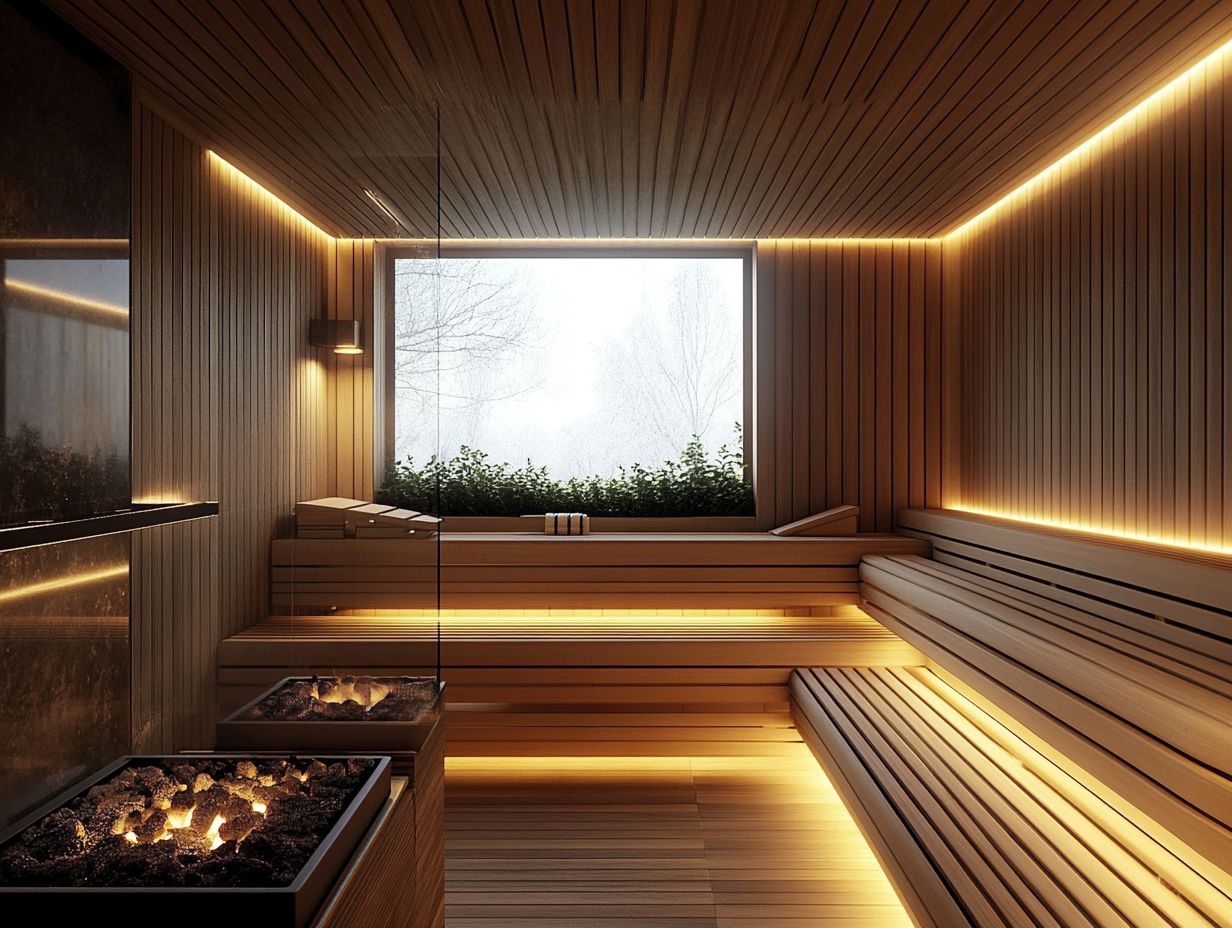
Choosing the right sauna design is essential for achieving both usefulness and appearance. Consider materials that resonate with your vision, such as cedar wood, known for its delightful natural aroma and remarkable durability.
Think about whether a sauna kit or a custom-built option aligns better with your home environment and personal style. Making this choice thoughtfully will elevate your sauna experience to new heights.
Factors to Consider
When considering a sauna for your home, keep several key factors in mind. Think about the available space for the sauna, the necessary ventilation system for optimal air quality, and your commitment to maintenance for safety and longevity.
Choosing the right sauna involves evaluating the area where it will be installed. This will determine the size and type that fit best. It’s essential to measure your designated sauna space accurately to avoid any unwelcome surprises during installation.
A well-designed ventilation system allows fresh air to circulate and prevents humidity buildup, enhancing your sauna experience. Don t forget to consider the upkeep involved; consistent maintenance is vital for optimal functioning and longevity. By understanding these elements, you ll set yourself up for a more satisfying and safe sauna experience.
DIY Sauna Design Ideas
Embarking on the journey of creating a DIY sauna can be a thrilling endeavor. It offers you the opportunity to tailor your sauna experience precisely to your liking. You can choose to indulge in a snug indoor retreat or embrace the invigorating ambiance of an outdoor sanctuary.
With a variety of sauna kits available or the option to design your own, you can seamlessly integrate your vision into the space you have. This allows you to reflect your personal style and preferences.
Outdoor vs. Indoor Saunas
The decision between an outdoor sauna and an indoor sauna depends on several important factors: the space you have available, your aesthetic preferences, and the sauna experience you desire. Each option presents unique advantages and creative possibilities for personalization.
If you re yearning for a peaceful retreat immersed in nature, an outdoor sauna offers a distinctive experience. You can bask in warmth while soaking in the beauty of your surroundings. Conversely, an indoor sauna can blend effortlessly with your home s decor, enhancing your living space while providing the convenience you crave, especially in chillier climates.
Consider the location; outdoor saunas require careful placement to ensure both privacy and easy access. Indoor options present their own challenges, such as plumbing and ventilation. Ultimately, both configurations can significantly enhance your relaxation and wellness journey. Your choice should truly reflect your individual preferences and lifestyle.
Custom vs. Pre-Built Saunas
When you’re choosing between custom and pre-built saunas, consider factors like cost, installation complexity, and your preference for sauna materials.
Pre-built saunas, often available in ready-to-assemble kits, simplify installation and can be a budget-friendly option for those seeking a quick setup. However, they might limit your choices regarding size, design, and materials, which could lessen your personalized experience.
Conversely, custom saunas provide great flexibility, allowing you to design a space that matches your dimensions, styles, and preferred hardwoods or other materials. While the initial investment and installation may take more effort, the long-term benefits of improved functionality and attractive looks often surpass any drawbacks for those eager to create a unique wellness retreat.
Building Your Own Sauna
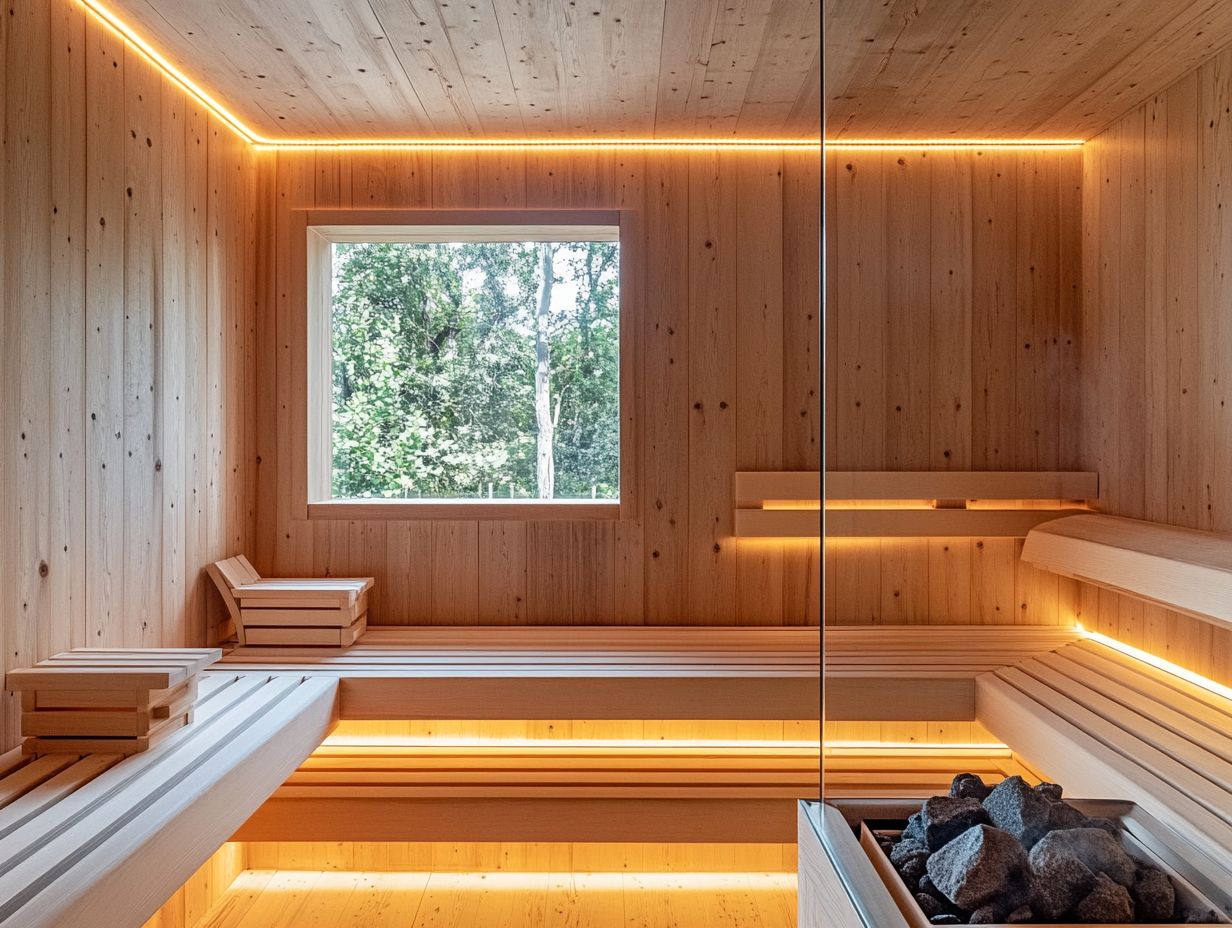
Building your own sauna can be an exciting adventure! You ll need to choose the best materials, understand the installation process, and decide on the best heating option whether it s a wood-burning sauna or an electric heater.
Step-by-Step Guide
A step-by-step guide to sauna installation includes several key stages. Start by selecting suitable materials, then install either a wood-burning stove or an electric heater, and finish with a proper ventilation system to ensure optimal air circulation.
Picking the right materials is crucial for both looks and durability; consider cedar, hemlock, or fir as excellent choices. Once you ve set up the base structure, focus on the heating system. You ll need to choose between a traditional wood-burning stove, which offers an authentic sauna experience, or a modern electric heater, known for its easy maintenance.
Understanding ventilation needs is essential for comfort. Proper airflow helps eliminate excess moisture and maintains a consistent temperature, making your sauna experience enjoyable and safe. Each of these steps is vital for enhancing your sauna’s overall functionality and comfort.
Safety Precautions
Ensuring sauna safety is key, whether you prefer a wood-burning sauna or an electric heater. Following specific maintenance protocols and conducting thorough checks for potential dangers will help create a secure sauna experience for everyone.
Important Considerations
When you focus on sauna safety, keep several important factors in mind. These include choosing the right sauna materials, using proper installation techniques, and implementing effective ventilation systems to prevent hazards.
Selecting non-toxic, heat-resistant materials like cedar or hemlock can enhance your comfort while reducing the risk of harmful emissions. Be sure to follow industry installation standards, like those from the American Society for Testing and Materials (ASTM), to avoid structural failures.
Ensuring proper airflow is essential for maintaining a balanced environment. Adequate ventilation prevents moisture buildup and decreases the likelihood of mold growth, both of which could harm your health and the sauna s longevity. By taking these precautions, you can create a safe and enjoyable experience for all.
Maintenance and Care for Your Sauna
Regular maintenance is essential for keeping your sauna functional and looking good. This includes routine cleaning, inspecting sauna materials, and ensuring a pleasant experience each time you enter.
Don t wait too long to clean your sauna; regular upkeep is key to enjoyment! By paying attention to these details, you’ll enhance your sauna’s lifespan and elevate each session’s enjoyment.
Tips for Keeping Your Sauna in Top Shape
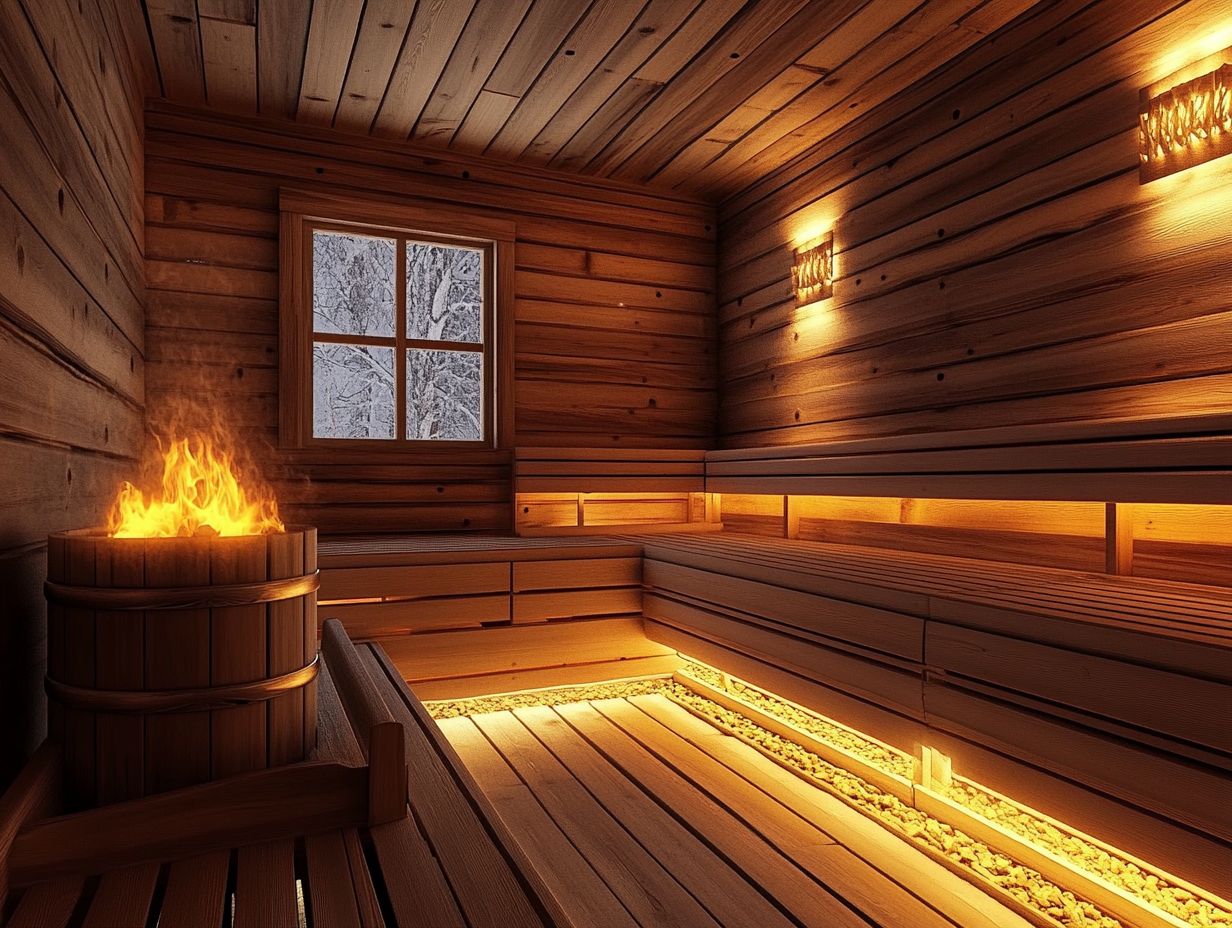
Keep your sauna looking amazing with regular cleaning and inspections! Pay attention to the materials to enhance your overall sauna experience.
Regularly check for damage to extend your sauna’s life and create a safe atmosphere. Use non-abrasive cleaners on wooden surfaces and avoid harsh chemicals.
Inspecting the heater and controls regularly is also wise. Incorporating natural elements like plants or stones will make your sauna a visually captivating retreat!
Frequently Asked Questions
What factors should I consider for a DIY sauna design?
Consider your available space, budget, and personal preferences. Think about the heat source and materials you want to use.
Are there various DIY sauna designs available?
Yes! You can choose from traditional wood-burning, electric, or infrared saunas. Each has its unique benefits.
Can I build a DIY sauna in a small space?
Absolutely! Many compact and space-saving DIY sauna designs are available for those with limited space. Get creative with the design to maximize your sauna’s footprint.
What materials are commonly used for DIY saunas?
The most common materials for DIY saunas are cedar, redwood, and hemlock. These woods are durable and resistant to heat and moisture.
Do I need construction or carpentry experience to build a DIY sauna?
While some designs may require basic skills, easy-to-assemble kits are available for those with little to no experience. These kits include all necessary materials and instructions for a hassle-free build.
Can I customize my DIY sauna design?
Yes! You can customize your DIY sauna to match your style and preferences. Choose the type of wood, heat source, layout, and size to create your perfect sauna.
Act now to protect your sauna and enjoy a relaxing experience! Start your DIY sauna project today!


